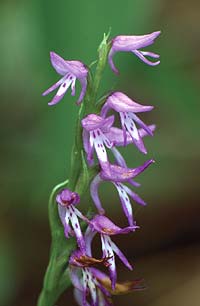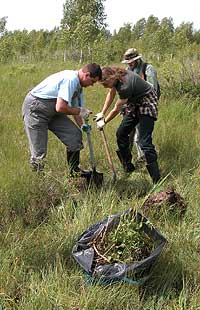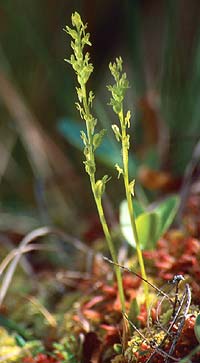|
15th |
WIGRY NATIONAL PARK
|
|||||
|
of "WIGRY"
|
Maciej Romański
Vascular plants
the earliest data concerning plant species occurring around Wigry date back to 1902 and come from an academic work for the general public by K. Kulwiec A journal of a trip to Wigry. the subsequent information on this subject appeared in the 1920s and was prepared by J. Woloszynska and B. Hryniewicki. B. Hryniewicki pointed out that a lot of rare plant species are found here, such as, for example, lady’s slippers Cypripedium calceolus, Neottianthe cucullata or Gentiana pneumonanthe. Unfortunately, many works from the period before World War II went missing and valuable information was lost.
During the existence of the Wigry National Park its area has been visited by botanists from universities all over Poland, and the state of knowledge of its flora has been expanded further. Also the scientists from the Scientific and Research Laboratory of the Wigry National Park have contributed to better knowledge of the flora of this area. At present, on the list of vascular plants in the WNP there are 999 taxa of native vascular plants, alien species which have made the Park their home for good, and some cultivated plants. the list is, by no means, closed, and it will continue to expand with time. Particularly little is still known of species and varieties of cultivated and decorative plants grown in the WNP.
After the war, the first mentions of flora of this area began to appear in the 1960s. More data were accumulated in the 1970s. However, they were fragmentary works, not presenting the flora around Wigry in a comprehensive way. the first exhaustive studies of the flora round Lake Wigry were carried out only in the 1980s., mainly thanks to the studies by prof. A. W. Sokolowski. a work by this author called Flora in the Wigry National Park came out at the same time when the Wigry National Park was established. in his work, on the basis of his own research and that done by others, the author lists the occurrence of 794 species of vascular plants, which are found in the Park. After the establishment of the Wigry National Park, a lot of new researchers and works appeared. the studies by A. Jutrzenka-Trzebiatowski, J. Dziedzic and T. Szarejko from 1994 contributed a lot of new information.
The flora of the Suwalki Region and the Wigry National Park is, at the same time, different from the flora in the remaining lowland part of Poland. It is a result of a different climate in this part of the country. The abundant occurrence of many protected, rare or species in danger of extinction is evidence of great value of the flora in the Wigry National Park. the occurrence of 70 taxa, submitted to complete protection and 20 under partial protection has been established in the WNP. There are 32 taxa of vascular plants, which are entered on the list in the Polish Red Book, and 53 are on the list of plants which are rare and becoming extinct in Poland. a great value of this area is also a less numerous, than in other regions of Poland, presence of alien species, which are a real threat to our native species.
Among the most valuable species occurring in the Park the following ones can be listed: the birch-tree Betula humilis, Baeothryon alpinum, Hammarbya paludosa, Malaxis monophyllos, Liparis loeselli, Dactylorhiza baltica, Dactylorhiza ruthei, Dactylorhiza incarnata subs.ochroleuca, Neottianthe cucullata, Cypripedium calceolus, Viola epipsila, Saxifraga hirculus, Carex chordorrhiza, Oxycoccus microcarpus, the Greek valerian Polemonium coeruleum, the cotton-grass Eripphorum gracile, the pond-weed Potamogeton filiformis and Gröenlandia densa.
It is also worth noticing that there are a lot of protected species, such as the martagon lily Lilium martagon, the daphne Daphne mezereum or the foxglove Digitalis grandiflora. They are less numerous in other parts of Poland or even rare.
The Wigry National Park not only gathers information on the flora occurring in it, but also undertakes an active protection aiming at saving the species in danger of extinction. Cutting grass on wet meadows, which have been out of use for many years, is an example of such activities. They aim at preserving habitats of many rare plant species connected with open ground. Also works consisting in keeping the right structure of tree-stands are conducted, which is important for preservation of valuable forest species.
|
|||||
|
|
|




